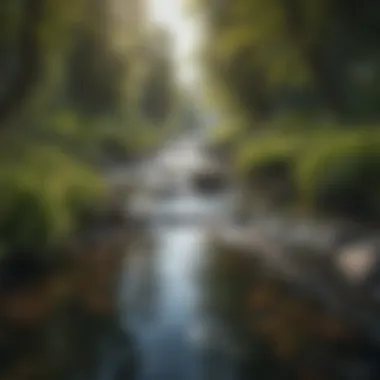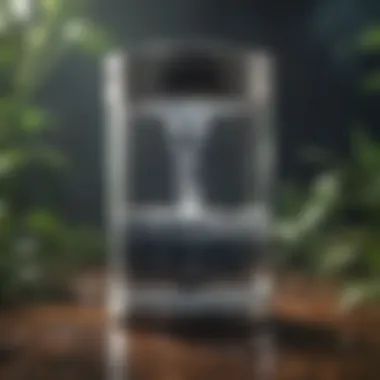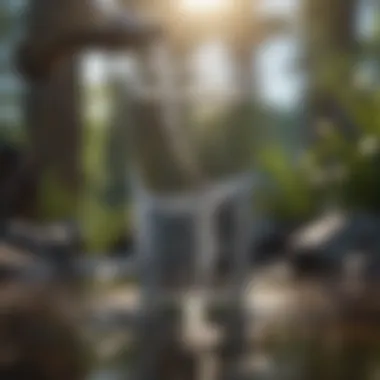River Water Purifiers: A Kids' Guide to Clean Water


Intro
Water is life, and rivers are the veins of our planet. Yet, the water flowing through these streams isn't always clean. Sometimes, it carries dirt, bacteria, and other harmful substances. This is where river water purifiers come into play. They are devices designed to remove impurities, ensuring that the water we drink is safe.
In this article, we will explore how river water purifiers work, the importance of clean water for both humans and wildlife, and why it’s essential to protect our natural resources. Through engaging facts, wildlife insights, and fun activities, we’ll help young readers grasp the concept of water purification while appreciating the beauty of nature.
Preface to Water Purification
Water is essential for life. It’s what keeps our bodies, animals, and plants humming along every day. However, not all water is safe to drink. This is where water purification comes into play.
Water purification means cleaning water to make sure it is safe for drinking and other uses. It helps remove dirt, bacteria, and harmful chemicals that can make us sick. For kids, understanding the basics of water purification is not just important—it's also fun! It’s like being a superhero who fights against dirty water!
What is Water Purification?
Water purification is the process of removing impurities from water. This includes various methods to clear away harmful particles, bacteria, and toxins. Think of it as cleaning a muddy glass until it’s crystal clear again.
There are different ways to purify water, such as:
- Filtration: This method uses filters to trap dirt and germs.
- Boiling: Heating water until it bubbles can kill many harmful organisms.
- Chemical Treatments: Adding certain chemicals can eliminate bad pathogens.
Kids can learn how these techniques work and even try some simple experiments at home!
Why is Clean Water Important?
Clean water is crucial for several reasons:
- Health: Drinking contaminated water can cause many illnesses, like diarrhea or even more severe diseases. Keeping water clean means keeping ourselves and our communities healthy.
- Wildlife: Rivers and lakes support many creatures. When water is polluted, it can harm fish, birds, and plants. Nurturing the environment ensures that all living beings can thrive.
- Fun and Recreation: Clean water makes for safe swimming, fishing, and other activities. Imagine a day at the beach or cooling off in a clear lake!
"Water is the driving force of all nature." - Leonardo da Vinci
By learning about water purification, children become more aware of their environment and the resources available to them.
Understanding River Water Contamination
Understanding river water contamination is crucial for grasping why river water purifiers are necessary. Rivers are lifelines, serving as sources of drinking water, habitats for wildlife, and pathways for various activities such as fishing and swimming. However, when rivers become polluted, the consequences can ripple through the ecosystem and human communities. The ability to identify sources of pollution and their effects helps us to appreciate the role of purifiers in ensuring clean water.
Common Sources of River Pollution
Rivers can be like highways for all kinds of unwanted materials. Let’s break down some of the common sources of river pollution:
- Industrial Waste: Factories often discharge chemicals and waste materials directly into rivers. This can harm aquatic life and contaminate the water.
- Agricultural Runoff: When it rains, fertilizers, pesticides, and herbicides from farms can wash into rivers. These chemicals can cause severe damage to plant and animal life.
- Sewage and Wastewater: Sometimes, cities do not treat their sewage properly, leading to human waste finding its way into rivers. This not only smells bad but can also spread diseases among people and animals.
- Plastic Debris: Items like bottles and bags can end up in rivers, choking wildlife and polluting the water.
These sources might be like hidden traps; often unnoticed, yet they directly affect the health of ecosystems.
Effects of Polluted Water on Ecosystems
The pollution of river water doesn’t just impact humans. It creates a domino effect on entire ecosystems. Here’s how:
- Loss of Biodiversity: Many aquatic species cannot survive in polluted waters. Fish, frogs, and even small insects can die off, leading to fewer species.
- Food Chain Disruption: When some species disappear, it disturbs the food chain. For instance, if small fish die out, larger fish that rely on them as food will also struggle.
- Algal Blooms: Excess nutrients from fertilizers can trigger algal blooms, which suffocate waterways and create dead zones where no life can exist.
- Health Risks: Polluted rivers can lead to contaminated water supplies, potentially causing serious health issues for both humans and animals.
Pollution of river water can create a cycle of harm that affects everything—insects, fish, mammals, and us humans too.
Understanding these facets of river water contamination can awaken a sense of responsibility. It’s not just about having clean water; it’s about preserving the entire ecosystem for future generations.


Types of River Water Purifiers
Understanding the different types of river water purifiers is crucial for anyone interested in how we can keep our water clean and safe. Each type has its own unique way of filtering out dirt and germs, making the water suitable for drinking. It’s like choosing the right tools for a job; knowing the right type of purifier helps people to pick one that fits their needs. Let’s explore the specific kinds of purifiers, their benefits, and a few things to think about when selecting one!
Mechanical Filters
Mechanical filters work by physically removing particles from water. Think of it like a coffee filter catching coffee grounds while letting the liquid flow through. These filters usually use mesh screens or sand to catch larger debris, leaves or even small insects.
Benefits of Mechanical Filters:
- Simple to Use: They often don’t need complicated setups. You just pour the water through them!
- Low Maintenance: Once set up, they can last a long time if cleaned regularly.
However, they may not be able to remove smaller bacteria or viruses. Therefore, it’s wise to combine these filters with another purification method for better results.
Chemical Purifiers
Chemical purifiers use substances like chlorine or iodine to kill germs in the water. Sounds like magic, right? Well, it’s science! These chemicals can be very effective at making water safe to drink, but they need to be used correctly.
Things to Consider:
- Chemical Taste: Some people find that this method can leave an odd taste in the water.
- Careful Measurements: It’s important to use the right amount of chemicals, as too much can be harmful.
Overall, chemical purifiers do a great job of disinfecting water, but it’s sometimes preferable to opt for methods that don’t affect the taste of the water.
Ultraviolet Light Purification
Ultraviolet (UV) light purification is like giving water a sunbath! This method uses UV rays to kill germs and bacteria by shining light through the water. It’s a technology that’s becoming popular because it’s super effective without any chemicals.
Why Choose Ultraviolet Light?
- No Chemicals Needed: This process doesn't change the taste of water at all.
- Quick and Efficient: It can purify water in just a matter of minutes!
However, it’s essential for users to have a power supply because UV purifiers need electricity to function, which can be a drawback for outdoor adventures or in off-grid situations.
Solar Water Purifiers
Solar water purifiers utilize the power of the sun to clean water. This method is both eco-friendly and innovative. The sun's rays can kill bacteria and viruses, and some models even distill water.
Advantages:
- Renewable Energy Source: Using sunlight is a sustainable option!
- Portable Options Available: Many solar purifiers can be taken along when on trips, making them great for camping.
However, relying on sunlight means these purifiers work best in sunny places and not so much on cloudy or rainy days.
In summary, knowing about different types of river water purifiers is essential for making informed choices about drinking water safety. Each kind has its advantages and disadvantages, so people should think carefully about which one to use based on their specific needs.
How River Water Purifiers Work
Understanding how river water purifiers function is like peeling an onion; each layer reveals something more about how we can transform dirty water into something we can safely drink. For children, grasping this concept is crucial because it shows how science meets real-life needs, particularly when it comes to protecting our precious resource—water.
We often take clean drinking water for granted. However, the process that turns river water, which may contain dirt, harmful bacteria, and other impurities, into crystal clear, drinkable water is nothing short of fascinating. In this section, we’ll unravel the inner workings of river water purifiers, spotlighting the specific elements, benefits, and considerations that come into play while ensuring safe drinking water.
The Science of Filtration
At the heart of most river water purifiers lies the science of filtration. Filtration is simply a method of removing unwanted substances from water. Imagine a giant sponge—when you dip it into muddy water, the sponge soaks up the impurities, allowing cleaner water to flow through.


Here’s a simple breakdown:
- Mechanical Filters: These use a physical barrier to catch larger particles in the water. Think of them as a sieve; if you pour sand and rocks through it, only the water and tiny bits will pass.
- Activated Carbon: This nifty material has tiny holes that absorb chemicals and bad tastes, making the water taste fresh as if it just came from a pristine mountain spring.
The real magic happens when water flows through these filters. As it passes, all the gunk is caught, leaving you with a clearer, cleaner version that’s much safer to drink. This is a practical method used in many homes, even if it’s not always directly derived from river water.
Chemical Reactions in Purification
When it comes to purifying river water, it’s not only about filtration. Sometimes, mother nature needs a little help through chemical reactions. This is where chemistry comes into play, providing an effective way to eliminate unwanted elements.
Many river purifiers use special chemicals, such as chlorine, for disinfection. Here’s how it works:
- Adding Chemicals: When chemicals are introduced into polluted river water, they start to react with contaminants, making them harmless.
- Breaking Down Harmful Substances: This process can break apart harmful bacteria and other contaminants into simpler molecules, essentially neutralizing their harmful effects.
- Improving Taste and Smell: Alongside cleaning, these chemicals can also improve the taste and smell of water, ensuring that when you sip, it’s not just safe but enjoyable.
It’s essential, however, to keep in mind that the use of chemicals must be carefully balanced. Too much can lead to side effects that may be just as bad as the pollution they aim to eliminate.
Key Takeaway: Understanding how river water purifiers operate through filtration and chemical reactions helps us appreciate the science behind clean drinking water. By grasping these concepts, we not only become more informed individuals but also stewards of our environment, advocating for cleaner water sources.
The Importance of River Water Purification
When we take a sip of water, we often overlook the journey it makes to reach us. River water purification is essential, especially in our world where nature is increasingly affected by human activities. Understanding why it's vital is not just for scientists or environmentalists, but for every kid and their families, too.
Clean water serves as a fundamental element for health, growth, and happiness. River water, which makes up a considerable portion of our freshwater sources, must be treated before it can be consumed. Polluted water can contain an array of harmful materials—from chemicals to tiny, unseen organisms. This is where river water purifiers come into play, clearing up the mess so we can enjoy what should be pure.
Protecting Human Health
Numerous diseases arise from drinking polluted water. Contaminated rivers can be the source of illnesses like diarrhea, cholera, and even more severe ailments. Kids, in particular, are more susceptible to the harmful effects of drinking unsafe water since their systems are still developing.
Purifying river water helps to ensure that families can drink what they believe to be clean. This process doesn't just mean filtering out big stuff like dirt—it also targets bacteria and viruses that are invisible to the naked eye. Here are some critical aspects of how purifying water keeps kids and families safe:
- Reduces illness: Clean water prevents various diseases that can affect children and adults alike.
- Supports proper hydration: With safe water, children can remain healthy and active, enjoying playtime without the risk of getting sick.
- Creates healthy habits: Learning about the importance of clean water enables kids to practice better hygiene and nutrition.
"Clean water is the foundation of a healthy life; it makes every drop count!"
It’s crucial for kids to grasp the significance of drinking safe water, along with how river purification makes that possible. Engaging them in discussions about why this matters can help shape future environmental stewards.
Safeguarding Wildlife
Beyond human health, river water purification impacts wildlife, too. Rivers teem with life, from the tiniest microorganisms to large animals like fish, birds, and mammals. When rivers get contaminated, the balance of these ecosystems can be thrown off.
Healthy rivers support complex interactions among species. For example, fish rely on clean water to thrive. If pollutants enter their habitat, it could lead to decreased populations or even local extinctions.
Some specific benefits of purifying river water for wildlife include:
- Maintaining biodiversity: Clean water supports a diverse range of species, ensuring that plants and animals can thrive together.
- Preventing habitat loss: When water is purified, the natural environment remains intact, allowing various wildlife to continue calling it home.
- Encouraging sustainable ecosystems: Keeping rivers clean ensures that all aspects of the local environment work in harmony, benefiting both wildlife and humans.
DIY Water Purification Activities
Getting hands-on with water purification activities can really spark a child's interest in science and nature. These activities show that anyone can help make the world a cleaner place, right from their own home or school. Learning by doing is powerful. When kids build their own filters or try out simple experiments, they not only understand the importance of clean water but also develop critical thinking skills.
Doing DIY water purification projects can be fun and very educational. Kids get to see how different methods work and the science behind them. This practical knowledge reinforces classroom learning and helps them appreciate nature more. Plus, it can be a great bonding time for families, encouraging teamwork and collaboration.
Simple Experiments for Kids


Here are a few experiments that kids can easily do at home with some common materials:
- Disappearing Water Experiment: Fill a glass with muddy river water and let it sit for a few hours. Kids will observe how the dirt settles to the bottom, showing the importance of time in natural purification.
- Varying Filter Materials: Get different materials like coffee filters, cotton balls, and sand. They can layer these in a cup and pour dirty water through them. Kids will see how each material cleans the water differently, showcasing how various filtration tools work.
- Colorful Art with Algae: Use simple pond water with algae to create colorful art. Mix a little of the water with paint and let children create art. Afterward, discuss what they see floating in the water and how that is part of the larger ecosystem.
These experiments show that water filtration isn't just about cleaning water but also about understanding ecosystems. Kids will learn why it's important to keep water bodies healthy.
Building a Sand Filter
Making a sand filter is a simple way for kids to learn about the basics of water purification. This project can be done with items easily found around the home:
Materials Needed:
- A plastic bottle (cut in half) or a jar
- Gravel
- Sand
- Activated charcoal (optional, but great for this project)
- Cheesecloth or coffee filter
- Dirty water (make sure it's safe to handle)
Steps:
- Prepare the Bottle: In the bottom half of the bottle, add a piece of cheesecloth or a coffee filter. This will act as a barrier to hold the filter materials in place.
- Layering: Add a layer of gravel, followed by a layer of sand. If you have activated charcoal, add a layer of that too. Each layer helps catch different particles.
- Pour Water: Slowly pour the muddy water into the top of the filter. Kids can observe how water flows through the layers.
- Collect Clean Water: The water that drips out of the bottom will be cleaner than what went in! Kids can test its clarity and discuss how effective their filter was.
This project not only teaches kids about filtration but also gets them thinking about the impact of pollution and the importance of keeping our water sources clean.
"The best way to predict the future is to create it."
By engaging in these DIY projects, young learners not only grasp concepts in science and nature but also feel empowered to make a difference. They help create a sense of stewardship towards the environment that can last a lifetime.
Future of Water Purification Technologies
The future of water purification technologies holds thrilling potential for how we address our ongoing water quality issues. As our environment faces challenges from pollution and climate change, these innovations can play a key role in making sure everyone—especially young people—understands that clean water is vital for health and ecosystems. With the right tools and knowledge, kids can grow up understanding the importance of sustainable practices when it comes to water use and conservation.
Innovations in Filtration
New advancements in filtration technology are cropping up all the time, changing how we think about cleaning water. Some notable methods include:
- Nanotechnology Filters: These filters use tiny particles to trap contaminants that regular filters might miss. Imagine having a filter that is so small, it can catch individual germs and pollutants, making the water crystal clear and safe to drink.
- Biomimicry: Some scientists design filters that copy the way nature cleans water. For instance, they may use materials inspired by the skin of certain fish, which effectively blocks out harmful microorganisms without removing beneficial elements.
- Advanced Membrane Technology: Specialized membranes can separate impurities from water. These membranes could be as thin as a human hair, yet stronger than concrete!
"The quest for cleaner water is like exploring a vast ocean of possibilities—there’s always something new lurking beneath the surface to discover!"
Sustainable Practices for Clean Water
Sustainability is a huge part of ensuring clean water for today and future generations. Here are some simple practices that kids can adopt:
- Reduce Plastic Use: Every time we choose reusable water bottles over single-use plastic, we help keep our rivers and oceans cleaner.
- Plant Trees and Vegetation: Trees can help filter water as it runs off the land. They also provide shade and homes for wildlife.
- Participate in Clean-up Events: Cleaning up local rivers and parks keeps trash out of the water supply and teaches kids about the importance of their actions.
- Educate Others: Sharing knowledge about the importance of clean water can inspire others to join in the fight against pollution.
Embracing sustainable practices at a young age can set the stage for a healthier planet. It's all about working together, staying informed, and doing our part to ensure that everyone has access to clean water.
Culmination
When we wrap up our discussion on river water purifiers, it’s crucial to understand why this topic matters. Water purifiers are more than just gadgets; they play a vital role in maintaining the health of both people and the environment. Understanding how these devices work can inspire young minds to appreciate nature and its intricacies.
Summary of Key Points
In this article, we have explored various aspects of river water purification. Here’s a quick rundown of the essential points:
- Water Purification Significance: Clean water is essential for human health. We need it for drinking, cooking, and hygiene.
- River Water Pollution Sources: Industrial waste, agricultural runoff, and litter can pollute rivers, making water unsafe.
- Different Purifiers: Mechanical filters, chemical purifiers, and UV light purifiers each have unique methods for cleaning water.
- How They Work: Filtration removes physical impurities, while chemical processes neutralize harmful substances.
- Future Technologies: Innovations like solar purifiers and sustainable practices promise cleaner water for all.
"Water is life, and clean water means a healthy life."
Encouragement for Young Nature Enthusiasts
To all the budding explorers and nature lovers out there, we encourage you to play your part in protecting our water sources. Whether it’s learning how to build a simple sand filter or participating in community clean-up events, every little bit helps. Remember, even the smallest effort can make waves in preserving our planet’s precious resources.
Be curious about nature! Ask questions and seek solutions. When you understand the importance of clean water and the technology behind it, you become a part of the solution, ensuring our rivers remain vibrant habitats for all the creatures that depend on them.







